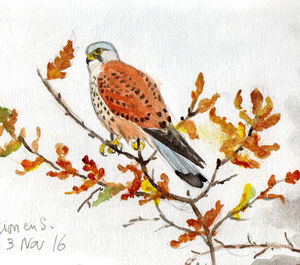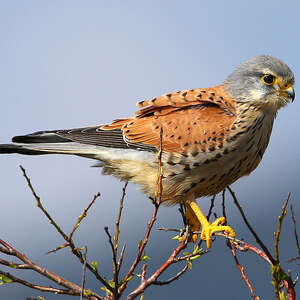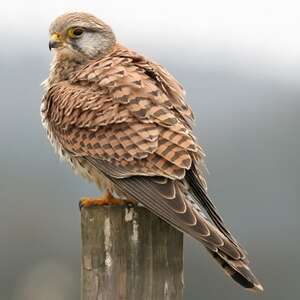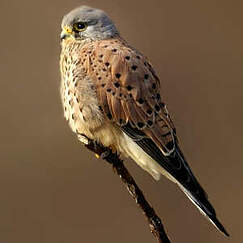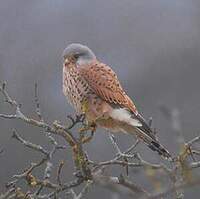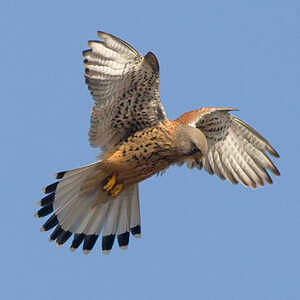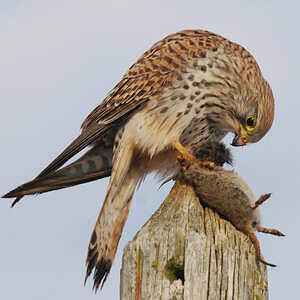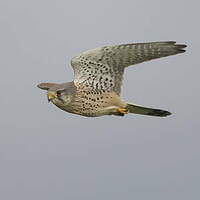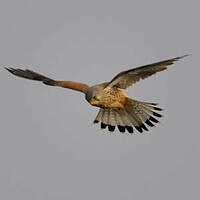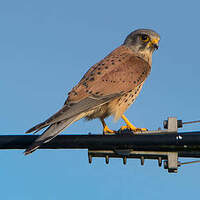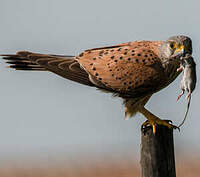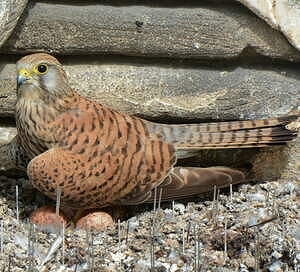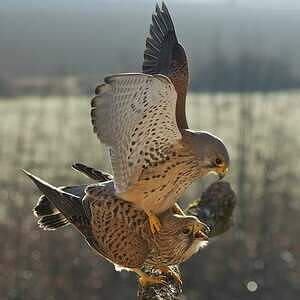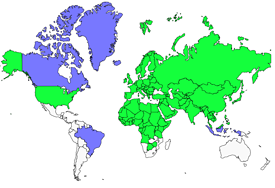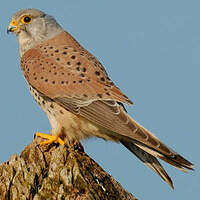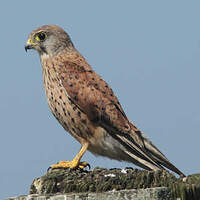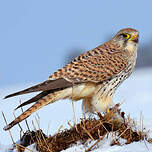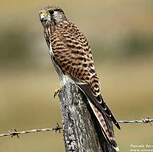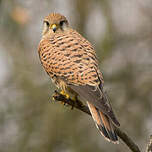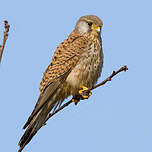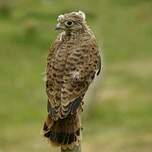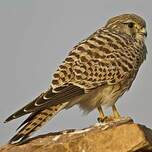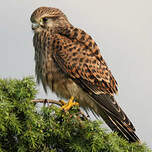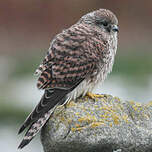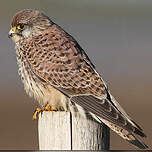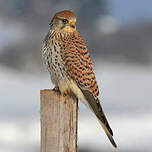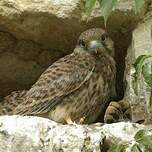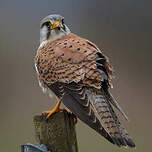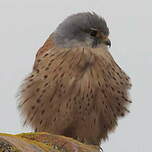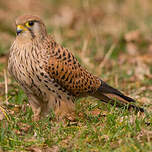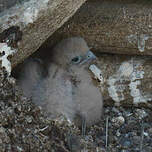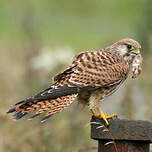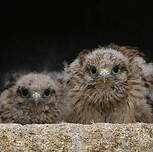Common Kestrel
Falco tinnunculus - Faucon crécerelle
Identification
Common Kestrel is a small falcon found in open habitats of the Old World. It is a slim-bodied bird with long, narrow wings and a long tail. In appearance, it is similar to other species of the Kestrel genus and misidentification is possible. The species is dimorphic. The adult male, smaller than the female, can be recognized by its contrasting plumage. The head is grayish on top and on the sides. Below the dark eye, ringed in yellow, a wide blackish line separates the gray ear coverts from the cream throat. The wax of the beak is very yellow. The upper parts, of a fairly vivid reddish-brown, are spotted with dark brown. The light gray tail is barred with black at its end very visibly. The gray goes up on the upper-tail coverts and the rump. The lower parts, cream at the throat and russet lower down, are clearly striated or spotted with black-brown, stripes on the chest, larger spots on the flanks. The legs are very yellow with black claws. The adult female is generally more uniform. It lacks the gray color characteristic of the male. Only the tail of older females can be gray. The upper parts are a mousey-reddish, from the beak to the tail, and more abundantly spotted. The remiges are less dark. The dark bar under the eye is less pronounced but the paler ear coverts still make it very obvious. The tail is distinctly barred with brown along its entire length, with a larger terminal bar. The chick is covered with whitish down. The juvenile resembles the female, but the plumage is duller, less warm and above all more heavily barred/spotted. The areas of bare skin are paler yellow. The immature is not easy to sex.Size is a good indication, but it is only with the appearance of grey in the plumage that we can be sure of having a male. Ten subspecies are currently recognized, which differ in size, coloration, intensity of feather spots and tail pattern.
Subspecific information 11 subspecies
- Falco tinnunculus tinnunculus (Europe and nw Africa to Siberia)
- Falco tinnunculus perpallidus (ne Siberia to ne China and Korea)
- Falco tinnunculus interstinctus (Himalayas to Japan and Indochina)
- Falco tinnunculus objurgatus (s India, Sri Lanka)
- Falco tinnunculus canariensis (Madeira and w Canary Is.)
- Falco tinnunculus dacotiae (e Canary Is.)
- Falco tinnunculus neglectus (n Cape Verde Is.)
- Falco tinnunculus alexandri (s Cape Verde Is.)
- Falco tinnunculus rupicolaeformis (ne Africa and Arabia)
- Falco tinnunculus archeri (Socotra I., Somalia, ne Kenya)
- Falco tinnunculus rufescens (West Africa to Ethiopia south to n Angola and Tanzania)
Foreign names
- Faucon crécerelle,
- Cernícalo vulgar,
- peneireiro-eurasiático,
- Turmfalke,
- vörös vércse,
- Torenvalk,
- Gheppio,
- tornfalk,
- Tårnfalk,
- sokol myšiar (pustovka),
- poštolka obecná,
- Tårnfalk,
- tuulihaukka,
- Rooivalk,
- xoriguer comú,
- Turnfálki,
- pustułka (zwyczajna),
- lauku piekūns,
- postovka,
- Пустельга,
- Alap-alap erasia,
- チョウゲンボウ,
- 红隼,
- เหยี่ยวเคสเตรล,
- 紅隼,
Voice song and cries
The species is usually quiet outside of the breeding season. The usual call, which can be considered an alarm call, is a rapid succession of high-pitched ringing notes ki ki ki ki ki kik that sometimes resembles the call of a woodpecker. During the breeding season, the pair produce sharp territorial tsik calls, emitted while in flight or perched, as well as long and piercing contact cries which can be translated as kiiih kiiih kiiih kiiih... at a relatively slow pace, with many variations on the same theme. At the nest, the couple's repertoire in the intimacy diversifies during 'parades' and mating. They are always series of cries like the previous ones, but with great variability in timbre and tone. The male bringing in food calls to the female at the nest with small tsics.
Habitat
The Common Kestrel is a highly adaptable species which goes well with many different landscapes. In fact, it is found from sea level to over 3,000 meters of altitude, from semi-deserts to sub-arctic regions.
Behaviour character trait
The Common Kestrel is a resident bird in most of its range. Only the northernmost populations are migratory. It is a rather solitary bird outside of the breeding period. It reproduces in isolated and territorial pairs, while closely related species such as the Lesser Kestrel are more or less colonial. Being a large consumer of small rodents, particularly voles, it is a valuable aid to agriculture in limiting their populations, even if it is overwhelmed by their abundance during episodic outbreaks. But it is not alone. It is well known and recognized for its stationary hunting flight, which it systematically practices, particularly over road embankments, known for being havens for rodents.
This typical flight is called flight in the Holy Spirit. It enables it to compensate for the lack of high lookout posts in areas rich in small mammals. It has a particular affinity for the rocky environment with vertical walls where it can reproduce. It naturally finds them in the hilly and mountainous levels, or with the advantage of quarries. This affinity for rock has led it to built-up areas which represent an ecological equivalent for rocky walls. It is in this environment that it can interfere with man and his activities, but with a little understanding on the part of the latter, cohabitation goes very well. It is even possible to favour its nesting in the urban environment by the installation of artificial nest boxes since the renovation of habitat deprives it of potential nesting sites. It is a rather quiet bird in ordinary time, but it becomes very vocal during the breeding season and thus attracts attention to it. If another raptor such as the Variable Buzzard or the Black Kite passes through its territory, it is pursued and expelled with loud cries.Flight
Even if it is capable of burst of speed occasionally, the Common Kestrel has overall slow flight. It does not have the velocity of the Hobby for instance, which is about the same size.
Its wing beats lack energy and amplitude. This difference between the two species is easily explained. The Hobby is a bird-eater which captures its prey during flight after a quick pursuit, while the Kestrel is a small rodent-eating bird which captures its prey from a stoop or after a brief dive after searching while hovering. This so-called Hover-hunt is done systematically, even in the absence of wind or perch. At the courtship ritual that precedes the reproduction, the Kestrels are very demonstrative and then capable of spectacular dives, especially from the male, and fast pursuits, all punctuated with numerous screams. Some northern populations are migratory. That is when the half-length wings of the species take their full sense and allow for migratory flights over long distances.Dietfeeding habits
The Common Kestrel is primarily a predator of small mammals, particularly voles, in open spaces with sparse, herbaceous vegetation.
Secondly, it can hunt other available prey like lizards, small amphibians, large insects (orthoptera, carabid beetles, cockchafers, etc.), earthworms, etc. It sometimes hunts birds, but rather young ones. It hunts from a perch higher up in a tree, post or by hovering, and then glides down upon the prey that has been spotted earlier. Studies have shown that this kestrel is sensitive to a particular ultraviolet radiation emitted by the droppings of the small mammals that make up its prey, thus optimizing its hunt.Reproduction nesting
The Common Kestrel is monogamous and reproduces in territorial pairs. The breeding period depends on the altitude and the latitude: from April to July in Eurasia and the Maghreb, and from August to December in Africa south of the Sahara. The breeding site varies depending on the context. Whenever a rocky cliff is available, it is systematically occupied, as the species is fundamentally cliff-dwelling. When there is no rocky site, the nesting is tree-dwelling. In general, it is an old crow's nest that is occupied. Secondly, the species has adapted to human habitation and now commonly nests in old buildings with nesting cavities, towers, castles, bridges, large buildings, old farms, ruins, etc.
More recently, the species has colonized the pylons of medium and high voltage power lines, as these can be used as supports for the nesting of crows, the Carrion Crow, the Rook, and even the Common Raven locally. Like all members of the family, the kestrel does not build a nest. The female lays her eggs directly on the substrate. The clutch consists of 2 to 6 very colorful brown-red eggs laid at 2-day intervals and incubated by the female, supplied with food by the male at the nest site. The chicks at hatching are covered with a whitish down that gives way to a second grayish down. The juveniles are flying at 5 weeks and are taken care of for some time thereafter by the adults. They will be independent at around 2 months. In years where rodents are plentiful, falcons have a better reproductive success. In general, there is only one brood per breeding female. In the case of an early loss of the clutch, a replacement clutch can be laid. The mortality of the juveniles is 50 to 70% the first year.Experience shows that breeding couples in a protected environment such as a building are more successful in their reproduction than those which nest in trees or on pylons. The young are of age to reproduce from their second civil year.Geographic range
The Common Kestrel can be observed across Eurasia and most of northern Africa. It is absent from the Americas and Oceania. 10 subspecies share this vast space, 4 of them only in islands of the Atlantic, the Azores excepted. The species does not inhabit pure desert areas such as the Sahara or Gobi. In Europe, it is found from the north of Scandinavia to the Mediterranean. In contrast, in Russia it is rare and almost absent from Siberia. In Africa, wintering birds go down as far as Angola, Zimbabwe and Tanzania. All of South Asia is occupied, Sri Lanka, Malay Peninsula included, and the Philippines in winter. The birds migrate much more the further north they nest.
Threats - protection
IUCN conservation status
concern
in the Wild
threatened
evaluated
The Common Kestrel is a common species, but its populations can only suffer from the current changes taking place due to two negative factors, climate change and human activities, which have an impact on habitats and their inhabitants. The banalisation of landscapes and the constant increase in the use of chemicals in broad agricultural systems explain the decline of the species observed in so-called developed countries such as France, where the STOC EPS monitoring shows, for example, a decline of -19% over the period 2001-2018. We can fear that this decline will continue without major changes in the functioning of our societies. For example, we may wish for an agriculture that is less impactful on ecosystems.
Sources of information
- IOC World Bird List (v14.1), Gill, F and D Donsker (Eds). 2024-04-18.
- Atlas des oiseaux de France métropolitaine. Nidification et présence hivernale. , Issa Nidal et Muller Y
- Les rapaces diurnes et nocturnes d'Europe, M. Cuisin, P. Geroudet
- Avibase, Lepage Denis
- Birds of the World, The Cornell Lab of Ornithology
- xeno-canto, Sharing bird sounds from around the world,
Other sources of interest
 Specification sheet created on
08/07/2023 by Jean François
Specification sheet created on
08/07/2023 by Jean FrançoisTranslation by AI Oiseaux.net
published: 27-05-2020 - Updated: 28-10-2020
© 1996-2024 Oiseaux.net
- Accipitriformes
- Aegotheliformes
- Anseriformes
- Apodiformes
- Apterygiformes
- Bucerotiformes
- Caprimulgiformes
- Cariamiformes
- Casuariiformes
- Charadriiformes
- Ciconiiformes
- Coliiformes
- Columbiformes
- Coraciiformes
- Cuculiformes
- Eurypygiformes
- Falconiformes
- Galliformes
- Gaviiformes
- Gruiformes
- Leptosomiformes
- Mesitornithiformes
- Musophagiformes
- Nyctibiiformes
- Opisthocomiformes
- Otidiformes
- Passeriformes
- Pelecaniformes
- Phaethontiformes
- Phoenicopteriformes
- Piciformes
- Podargiformes
- Podicipediformes
- Procellariiformes
- Psittaciformes
- Pterocliformes
- Rheiformes
- Sphenisciformes
- Steatornithiformes
- Strigiformes
- Struthioniformes
- Suliformes
- Tinamiformes
- Trogoniformes

